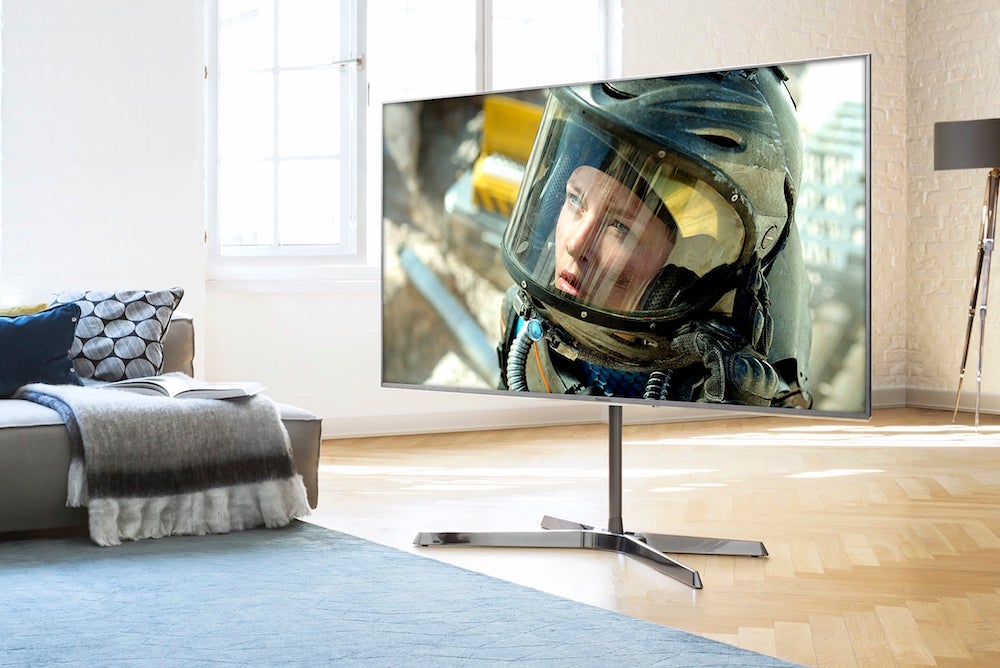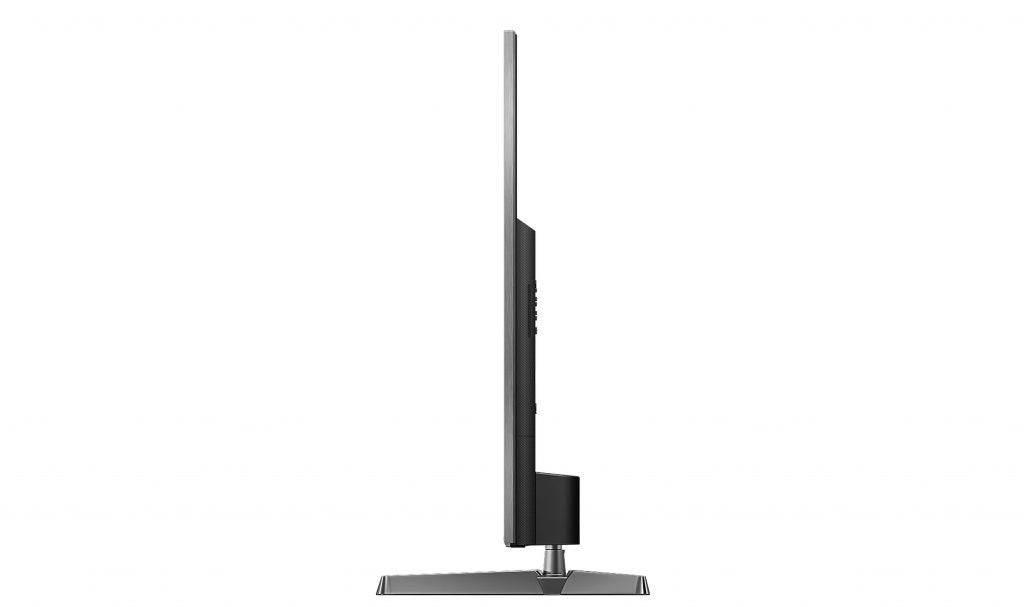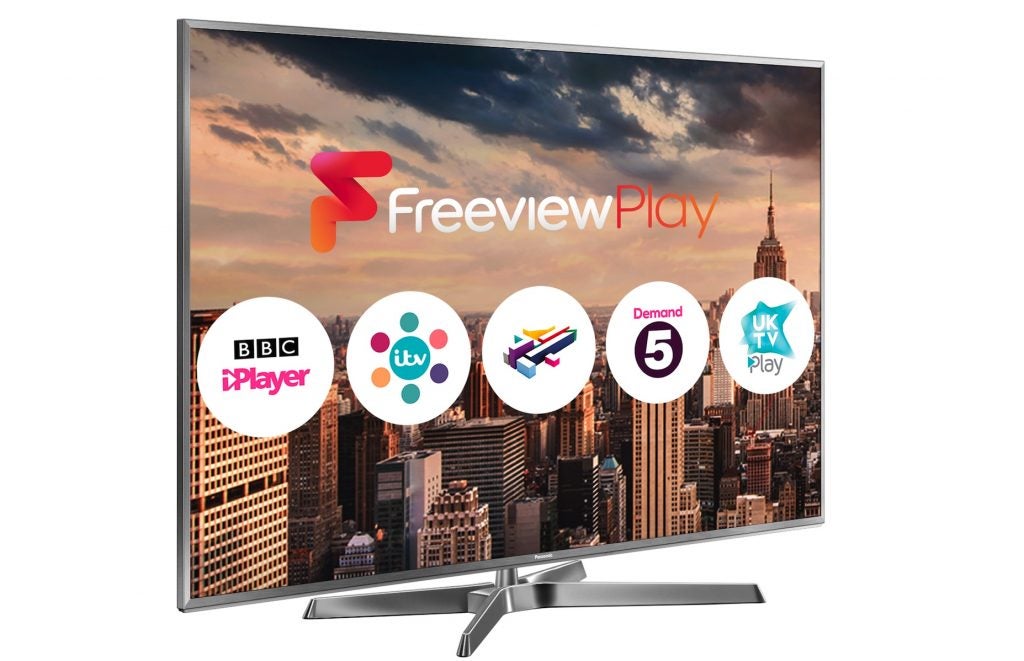Panasonic TX-65EX750 Review
Panasonic TX-65EX750
An intriguing, if slightly strange, addition to 2017's 4K TV selection
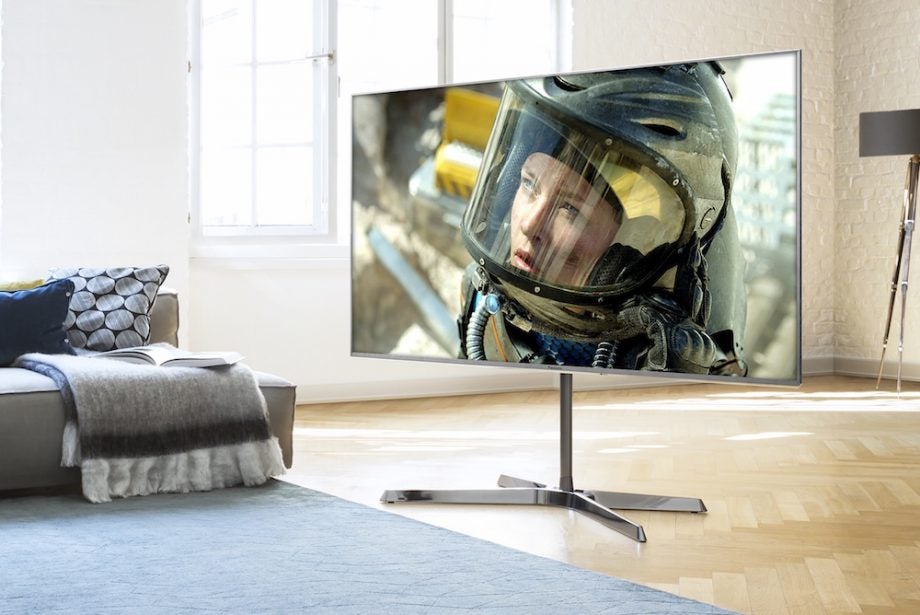
Verdict
Pros
- Good HDR pictures using the Dynamic preset
- Easy to use smart system
- Very low input lag
Cons
- Weak audio
- Strange colour inconsistency with most presets
- Not very bright for a premium HDR LCD TV
Key Specifications
- Review Price: £1899
- 65-inch LCD TV with edge LED lighting
- Native 4K resolution
- HDR10, HLG and upcoming HDR10+ HDR support
- Multimedia playback via DLNA and USB
- Digitally enhanced local dimming technology
What is the Panasonic TX-65EX750B?
Panasonic scored big critical hits with its EZ1002 and EZ952 2017 OLED TVs, and the company is hoping for similar success with its most high-end LCD TV for 2017, the EX750. And while it’s certainly not perfect, this TV combines a strikingly airy design with some genuinely new LCD backlight technology to mostly impressive effect. If you’re in the market for a big TV under £2000, this might do very nicely.
Tested here is the 65-inch version, the TX-65EX750B, which costs £1899. It’s also available at 58 inches (TX-58EX750B, £1,349) and 50 inches (TX-50EX750B, £1,129).
Related: Best TVs
Panasonic TX-65EX750 – Design and build quality
If you could judge a TV by its weight, the Panasonic TX-65EX750 would be a winner. The only LCD TV I’ve tested this year that weighs anywhere near as much is the £4,500, 65-inch Samsung Q9F QLED. Hopefully this points to some seriously high quality components inside to go with the impressively robust and heavy duty exterior.
While the Panasonic EX750 feels heavy, it doesn’t look it. Its frame is a touch wider than those of most modern TVs, but the silvery metallic finish and centrally mounted, cross-style desktop stand create a surprisingly light, airy feel. The stand lets you rotate the screen to face different viewing positions, which is unusual for a mainstream 65-inch LCD TV – you usually only see that sort of thing coming out of style-heavy brands such as Bang & Olufsen or Loewe.
Smaller EX750 models additionally let you adjust the screen’s height on its stand, but I guess this wasn’t sustainable with the 65-inch model.
The fact that the stand is centrally mounted means you can set the TV on a relatively narrow base. The depth of the ‘cross’ foot could potentially be a problem for especially shallow bits of furniture, but you wouldn’t really want such a heavy TV resting on anything flimsier.
The Panasonic TX-65EX750’s remote control looks cluttered and clunky by today’s standards, but it’s quite comfortable to hold and reasonably logical in its layout.
Panasonic TX-65EX750 – Features
The EX750 carries a native 4K Ultra HD resolution and support for high dynamic range playback. That high dynamic range support covers the industry standard HDR10 and broadcast-friendly HLG formats.
Panasonic also says the EX750 will be upgraded via firmware to handle the new HDR10+ format. This adds an extra layer of scene by scene information to the core HDR10 signal so that TVs can play it better. Don’t expect any support for the Dolby Vision HDR format any time soon, though.
The EX750 employs the brand’s new Studio Master HCX2 processing system. This is claimed to be Panasonic’s most powerful video processing system yet. Its key attractions are a professional-grade 3D Look Up Table approach to colour reproduction, as well as a range of other processing elements developed in collaboration with Panasonic’s Hollywood Labs. All with a view to delivering pictures with enough subtlety and refinement to get as close as possible to a filmmakers’ original vision.
Just as intriguing is the EX750’s ‘digitally enhanced local dimming system’. This combines traditional local dimming with a new shuttering system that adjusts the angle of each liquid crystal to receive light more effectively. The idea behind it is to deliver better contrast without such traditional unwanted local dimming side effects as bands of light around bright objects.
At the heart of the EX750 is an edge-lit ‘Super Bright Panel Plus’ LCD display. Panasonic claims this can sustain a higher brighter average picture level than normal TVs, and it does indeed hold on to bright HDR test feeds for longer than other HDR TVs.
There seems to be a price to pay for this in the screen’s maximum brightness. Its measured 522 nits of light output when fed our standard 10% white HDR window test signal really isn’t a lot of brightness. The similarly priced Samsung MU7000 reaches 700 nits. I’ll talk more about the various pros and cons of Panasonic’s approach to brightness in the performance section.
The EX750’s connections are as you’d expect of a premium LCD TV. Its four HDMIs all support 4K and HDR. Its three USBs ports enable recording from the Freeview HD tuner to USB HDDs, and playback of multimedia from USB storage devices.
Also, it carries both Wi-Fi and Ethernet network connections. These enable access to multimedia stored on networked DLNA devices, and Panasonic’s online service. Accessed via Panasonic’s attractive and easy to use Homescreen 2.0 interface, this service includes most of the services your typical TV user will be looking for.
That includes HDR and 4K-capable versions of Amazon and Netflix, plus slick access to the UK’s main terrestrial broadcaster catch-up services via a built-in Freeview Play app. The only thing I really found myself missing was a Now TV app.
The EX750’s final notable feature is also its most surprising: 3D playback. Pretty much every other TV released in 2017 – including other Panasonic models – has ditched 3D. Yet it’s supported here, using the active shutter format.
Before 3D fans get too excited, Panasonic couldn’t find a pair of 3D glasses for me to test the TV’s 3D talents. This speaks volumes about the standing of 3D with most TV makers these days.
Panasonic TX-65EX750 – Set Up
The 65EX750’s physical construction is trickier than normal thanks to the weight of the TV and the need to attach it to a swivelling stand. Definitely don’t attempt it by yourself!
Getting the best out of the 65EX750’s pictures isn’t difficult – but it is a bit weird. When watching HDR content, I found I pretty much had to use its Dynamic picture preset. I would never normally do this, as the Normal or, even better, Cinema and True Cinema presets are designed to deliver the most accurate performance. For me, though, the Dynamic mode was the only one that got the job done, for reasons I’ll discuss more in the performance section.
Another strange but positive setting quirk is that thanks (presumably) to the set’s new Digitally Enhanced Local Dimming technology, it’s possible to turn the set’s Adaptive Dimming to its maximum setting to maximise contrast without causing the usual backlight clouding and banding issues.
This setting does sacrifice some general brightness to deliver its enhanced contrast. If that troubles you, reducing the Adaptive Dimming to its mid setting introduces more brightness, albeit with greyer-looking blacks.
The only other general tips are to turn off all noise reduction for 4K content, and leave the Intelligent Frame Creation motion processing on its lowest setting to avoid unwanted processing artefacts.
Panasonic TX-65EX750 – Performance
The 65EX750 is capable of delivering an impressive HDR performance – but there’s a trick to it.
I started off my HDR tests using the Normal and then the True Cinema picture presets I’d normally expect to yield the best results. With the 65EX750, though, none of these settings set my pulse racing. They didn’t look bright enough, and left colours looking a bit wan.
Worse, these presets all clearly reveal a bizarre lack of colour consistency, where the left and right sides of the screen looked less saturated than the centre. There even seems to be an infusion of yellow into colours at the image’s sides.
I’m not talking here about thin slivers of different colour tone at the image’s left and right extremes. The inconsistency creeps in a good few inches from either side, and is particularly obvious with full-screen rich colours.
While the red Marvel logo, for instance, enjoys the familiar vibrant red over the central section of the picture, its left and right sides look markedly more washed out.
Fortunately this issue is greatly reduced by switching the picture preset to Dynamic. So much so that while it doesn’t completely go away, it’s seldom a distraction any more.
I can’t say for sure what causes this colour issue. The good news, though, is that as well as fixing it, the Dynamic setting delivers a surprisingly good HDR picture in other ways too.
Contrast looks strong. Inky blacks share the screen with reasonably crisp whites if you use the Adaptive Dimming feature on its Maximum setting. Even better, the screen manages to deliver peak HDR whites against dark backdrops with barely a hint of backlight haloing/blooming or striping/blocking.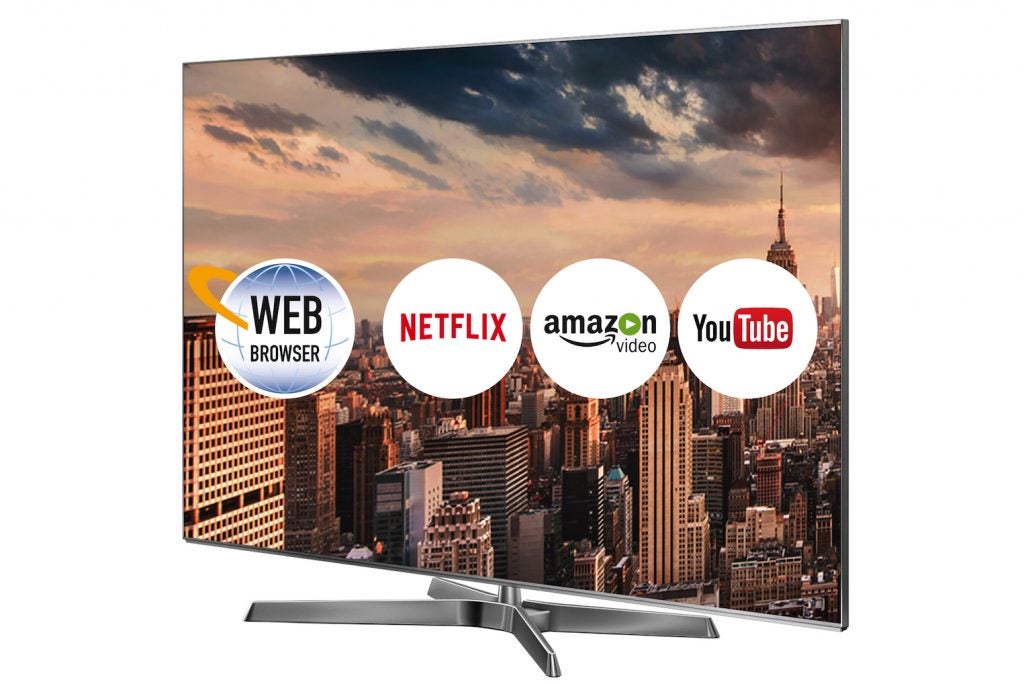
Presumably we have the digitally enhanced local dimming technology to thank for this avoidance of a near-universal HDR LCD issue.
This new light management system may also be responsible for the impressive amounts of shadow detail and subtle colour information the EX750 provides in dark scenes versus most rivals.
Panasonic’s processing prowess also means that even in Dynamic mode – not the sort of setting usually associated with ‘accuracy’ – colours look lovely.
There’s a gorgeous sense of subtlety to the rendering of colour blends, and a beautifully realistic, natural look to tones generally. Even without as much brightness to play with as I might like, the 65EX750 delivers a decent amount of punch and insight to Guardians Of The Galaxy Volume 2’s ultra-dynamic HDR colourscape. You’re never in doubt that you’re seeing an image dripping in HDR and Wide Colour Gamut (WCG) technology.
Panasonic’s processing is also on fine form with sharpness and detailing. Native 4K looks crisp, clean, full of textures and image depth, and untroubled by noise (unless it’s in the source).
Just as importantly, the EX750 upscales HD pictures to its native 4K resolution extremely effectively. There’s a clear increase in perceived detail and sharpness, and the upscaling is clever enough to add precise colour tone detailing without looking processed. It removes source noise intelligently before adding millions of extra pixels too, and upscales thin, contrasty edges without making them look stressed.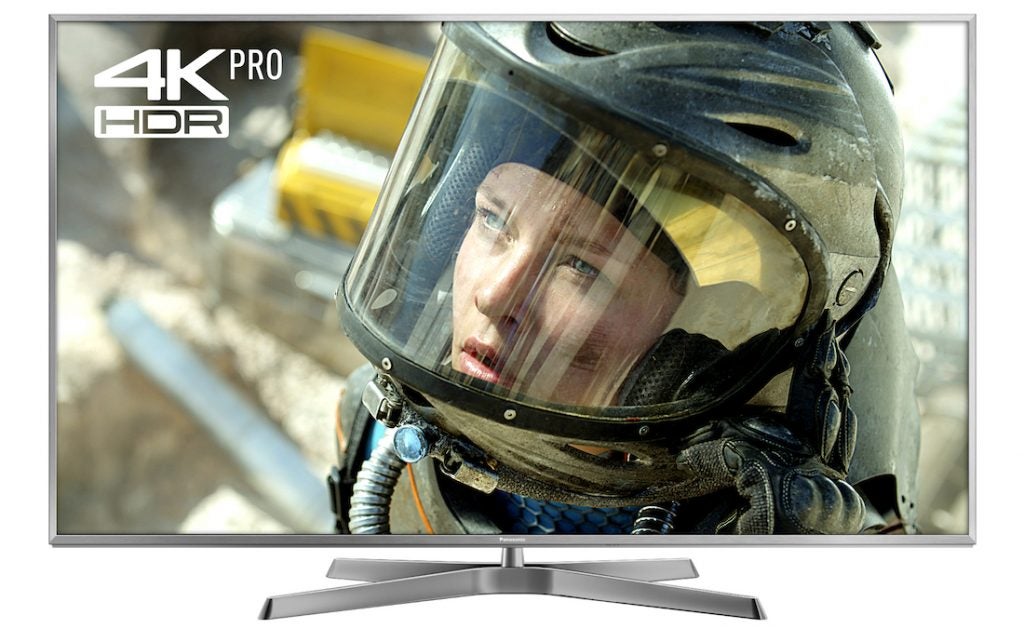
The 65EX750 is on fine form with standard dynamic range pictures, too. SDR’s much narrower colour and light range demands are handled effortlessly, without losing that sense of subtlety and finesse that seems to be a welcome trademark of Panasonic’s latest ‘Hollywood-tuned’ picture processing.
One final performance strength of the EX750 is its input lag. I measured a delay in producing images of just 10ms when using the provided Game picture preset. This is a superb result, far better than the average. What’s more, the Game mode isn’t as badly affected by the HDR colour consistency issue as the Natural, Cinema and True Cinema modes.
While the Dynamic image setting elevates the EX750 from passable to good, even this preset’s pictures needs a little tinkering. For instance, with the default Max Adaptive Dimming setting in play, bright HDR shots look a little dull. You can improve this by shifting down to the Medium dimming setting, but at the cost of quite sharply reduced black levels.
To put some numbers on this, you only get sub-400 nit light output on a 10% HDR white window with adaptive dimming on maximum, versus more than 500 nits with it on medium.
Having to make such a stark choice between more contrast and more brightness is a bit frustrating, but each Adaptive Dimming mode looks surprisingly good in its different ways – so long as you’re using the Dynamic picture preset.
My personal preference, for what it’s worth, was to leave adaptive dimming on Max. The extra contrast it provides creates the illusion that the image is actually brighter.
Overall, though, the 65EX750’s pictures in Dynamic mode are more than attractive enough for its £1900 price point. Which is more than can be said for its sound.
It really does sound thin for such a large TV. There’s hardly any bass, and the mid range is painfully narrow. Dialogue sounds a little dislocated from the onscreen action too, and there’s no real sense of sound stage expansion for action scenes.
There is, at least, no rattling from the cabinet, or phutting/buzzing interference from the speakers. It really doesn’t produce the scale of sound its pictures deserve, though, and falls short of the sound performance of a number of this year’s rival big-screen TVs. For proper movie enjoyment, you’ll want to invest in some speakers or a soundbar.
Related: Best soundbars
Should I buy a Panasonic TX-65EX750?
If you’re willing to sacrifice some HDR-friendly brightness for excellent backlight management, then the EX750 has got to be considered – especially at this price. Its new backlight technology is startlingly effective in the way it retains shadow detail, yet avoids typical backlight clouding and banding issues. Provided you don’t mind being limited to a pretty specific set up if you want to get the best from it.
If you’d rather unlock more of HDR’s brightness potential at the cost of less even backlighting, the Sony 65XE9305 can get almost three times brighter and sounds better – but costs £300 more.
The Samsung UE65MU8000 also offers more than twice as much brightness for around the same price as the 65EX750, but its backlighting creates more clouding.
Finally, if you don’t mind sacrificing 10 inches of picture, you can get the 55-inch LG OLED55B7 for £1800. This combines more brightness with the contrast benefits of OLED’s self-emissive pixel technology.
Verdict
The Panasonic TX-65EX750 requires a pretty non-standard set up to get the best out of it, but its new backlight technology is unique and effective. This is potentially catnip to AV fans looking for a good 65-inch TV for under £2000.
How we test televisions
We test every TV we review thoroughly over an extended period of time. We use industry standard tests to compare features properly. We’ll always tell you what we find. We never, ever, accept money to review a product.
Trusted Score
Score in detail
-
Features 9
-
Value 8
-
Smart TV 9
-
Image Quality 8
-
Design 8
-
Sound Quality 6
Features
| Size (Inch) | 65 |
| Display Type | LED |
| Max. Resolution | 3840 x 2160 |
| Full HD 1080p | Yes (actually 4K) |
| Digital Tuner | Yes |
| Freeview HD | Yes |
| Freesat HD | No |
| 3D Ready | Yes |
| Refresh Rate (Hertz) | 2400 |
Connectivity
| HDMI | 4 |
| Digital Audio Out | Yes |
| Headphone | Yes |
| Ethernet | Yes |
| WiFi | Yes |
Physical Specifications
| Height (Millimeter) | 841 |
| Width (Millimeter) | 1457 |
| Depth (Millimeter) | 52 |
| Weight (Gram) | 39000 |

